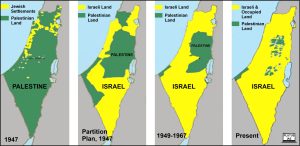09 Oct Israel-Palestine Conflict
This article covers “Daily Current Affairs” and the topic details “Israel-Palestine Conflict”. This topic has relevance in the International Relations section of the UPSC CSE exam.
For Prelims:
About the Israel-Palestine Conflict?
About Hamas?
For Mains:
GS 2: International Relations
Reasons for the Creation of Hamas?
Key Conflicts?
Why in the news?
After Palestinian militant organization Hamas launched attacks on Israel, resulting in a death toll of at least 400 people, Israel’s retaliatory actions in the Gaza Strip have resulted in the deaths of over 300 people.
Early Phases
- In the 19th century, Palestine was home to a diverse population consisting of approximately 86% Muslims, 10% Christians, and 4% Jews, living together in relative harmony.
- During the late 1800s, a European group known as Zionists emerged with the objective of establishing a Jewish homeland. They initially considered various locations in Africa and the Americas but ultimately chose Palestine as their destination.
- The rise of Adolf Hitler to power in Germany resulted in a significant increase in Jewish immigration to Palestine. This influx of Jewish settlers began to exacerbate tensions and conflicts in the region.
UN Partition Plan (1947)
- In 1947, the United Nations (UN) intervened in the Israel-Palestine conflict, but it did not adhere to the principle of “self-determination of peoples.”
- Under significant Zionist influence, the UN recommended allocating 55% of Palestine for a Jewish state, despite this group representing only about 30% of the total population and owning less than 7% of the land.
1947-1949 War
- Hostilities erupted almost immediately after the UN’s November 1947 Resolution.
- On May 14, 1948, one day before the expiration of the British Mandate (when Palestine was a British colony), Britain declared “the establishment of a Jewish State in Eretz-Israel, this event served as a catalyst for the outbreak of the 1948 Arab-Israeli War.
- By the war’s end, Israel had occupied 78% of Palestine, leading to the redrawing of territorial boundaries.
1967 War (Six-Day War)
- In the 1967 Six-Day War, Israeli forces launched a surprise attack on Egypt, achieving remarkable success.
- Israel occupied the remaining 22% of Palestine, including the West Bank and Gaza Strip, which had eluded it in 1948.
- Israel also occupied parts of Egypt (later returned) and Syria (still under occupation).
Oslo Peace Process (1993)
- In 1993, a significant breakthrough agreement was reached between Israeli and Palestinian leaders in Oslo, Norway.
- Under the Oslo Peace Process, the Israeli government and the Palestine Liberation Organization (PLO) devised a plan to implement a two-state solution, aiming to address the ongoing conflict.

About Hamas:
- Hamas is the largest among Palestinian militant Islamist organizations and is one of the two major political factions in the area.
- It currently governs more than two million Palestinians in the Gaza Strip.
- The organization is known for its armed resistance against Israel, which has led to its designation as a terrorist group by Israel, the United States, the European Union, the United Kingdom, and other countries.
Historical Context:
- Hamas was founded in the late 1980s, during the first Palestinian intifada (uprising) against Israel’s occupation of the West Bank and Gaza Strip.
- It can be seen as an internal evolution of the Palestinian Muslim Brotherhood.
Reasons for Creation:
- Hamas emerged in response to a sense of failure within the Palestinian national movement by the late 1980s.
- This sense of failure stemmed from the Palestine Liberation Organization’s (PLO) recognition of Israel’s right to exist and the abandonment of armed struggle as a strategy in favor of negotiations.
Opposition to Oslo Peace Accords:
- Hamas gained prominence by opposing the Oslo Peace Accords signed in the early 1990s between Israel and the PLO.
Key Conflicts:
- One of the deadliest confrontations between Hamas and Israel occurred in 2014, resulting in significant casualties on both sides.
- In May 2021, clashes at the Al Aqsa compound in Jerusalem led to violence, with Hamas launching rocket attacks from Gaza and Israel responding with airstrikes. The conflict lasted for 11 days.
Source: Timeline: The Palestinian and Israeli Conflict, Explained | Explained News – The Indian Express
Download plutus ias current affairs eng med 9th Oct 2023
Q.1 Consider the following statements regarding the Israel-Palestine conflict:
- The United Nations (UN) intervention in 1947 adhered strictly to the principle of “self-determination of peoples.”
- The 1948 Arab-Israeli War was triggered by the USA’s declaration establishing Israel.
Which of the statements given above is/are correct?
(a) 1 only
(b) 2 only
(c) Both 1 and 2
(d) Neither 1 nor 2
Q.2 Consider the following statements regarding Hamas:
- The organization is known for its peaceful negotiations with Israel, leading to improved relations.
- The sense of failure within the Palestinian national movement was a key factor in the emergence of Hamas.
Which of the statements given above is/are correct?
(a) 1 only
(b) 2 only
(c) Both 1 and 2
(d) Neither 1 nor 2
Q.3 Discuss India’s historical stance and evolving foreign policy towards the Israel-Palestine conflict. How has India’s position impacted its broader foreign policy objectives in the Middle East and its standing in global geopolitics?



No Comments